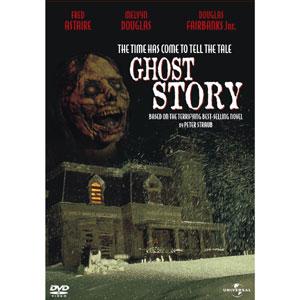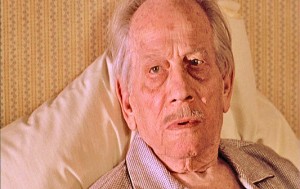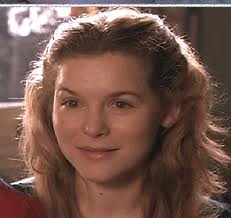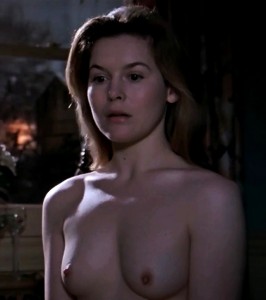Ghost Story
Universal Pictures, 1981
Directed by John Irvin
Screenplay by Lawrence D. Cohen, based on the novel by Peter Straub
Starring Fred Astaire, Melvyn Douglas, Douglas Fairbanks, Jr., John Houseman, Craig Wasson, Alice Krige, and Patricia Neal
Music by Philippe Sarde
I’ve been curious to see the 1981 horror film Ghost Story for a long time. I’ve always enjoyed watching films featuring major Hollywood stars of the Studio Age in their advanced years (personal favorites of the “geezer genre” include Burt Lancaster in Atlantic City and Melvin Douglas in Being There, with an appreciative nod to Edward G. Robinson in Soylent Green). Ghost Story is replete with major Hollywood stars in their dotage; it was the final film for Fred Astaire, Douglas Fairbanks, Jr., and Melvyn Douglas, and it also features Patricia Neal, who was the most amazingly unearthly aspect of When the Earth Stood Still. This past week, Dara and I changed our TV programming providers from Verizon Satellite to Comcast; when I discovered that Ghost Story was one of the “free movies” included with our package, I insisted that we watch it.
Ghost Story was released a year later than Stanley Kubrick’s The Shining, also an adaptation of a popular horror novel by a bestselling American horror author (Stephen King, rather than Peter Straub), and also involving spectral doings, deaths from decades past, and insanity played out against a wintertime backdrop. The Kubrick version of The Shining, whatever its debatable merits as an adaptation of King’s novel, still retains the capacity to spook and unsettle me, even after repeated viewings. Ghost Story, on the other hand, provided me with no chills at all. Which is not to say the film was not enjoyable; simply that it wasn’t scary.
Horror is an interest of mine, so I did a little thinking regarding why Ghost Story, despite the considerable acting talents involved, failed to register at all on the Scare-O-Meter (unlike earlier films involving hauntings, such as The Haunting and The Legend of Hell House, based on novels by Shirley Jackson and Richard Matheson, respectively). The film’s failing to rouse any sense of fright or even unease in me wasn’t due to the performances (with one exception — in the 1920s flashback scene, when each of the members of the Chowder Club is piss-faced drunk, they all giggle like little girls, indistinguishable from one another, which is extremely weird, but not in the way director John Irvin intended, I’m sure). Fred Astaire has never been a favorite of mine as a dramatic actor (as opposed to a dancing and singing romantic comedy star), although he isn’t bad in Ghost Story, and Douglas Fairbanks, Jr. is given regrettably little to do in his final film role (he gets killed off early). Craig Wasson plays a dual role, two brothers, one of whom is the film’s earliest (and most graphically slain) casualty. A face many viewers of a certain age will remember from extensive TV roles in the 1970s (including recurring roles as good-natured schlubs in The Bob Newhart Show and M*A*S*H), he is perfectly adequate for his role here, which doesn’t ask too much from him (probably the most grueling aspect of his performance is the lingering embarrassment he must’ve suffered over having his groin exposed in a bizarrely gratuitous flash of full-frontal nudity as he tumbles forty stories to his death after a supernatural shock sends him crashing through the window of his luxury apartment in Manhattan; I muttered to Dara, “Well, there’s your R rating right there”).
Two of the film’s performances are very good, however. Melvyn Douglas, far more so than any of his three venerable male co-stars, conveys very poignantly the helpless terror and shame of becoming physically debilitated by advanced age, and because he portrays that helplessness so well, the build-up to his death scene is much more gripping than the lead-ins to the deaths of any of the other male characters.
By far the best thing about the film (and maybe the only reason to watch it, unless you are a diehard fan of Astaire, Fairbanks, Douglas, or Houseman) is the performance of Alice Krige as Eva Galli / Alma Mobley. She is stunningly gorgeous in this film, both in the 1920s flashback scenes and in the modern day scenes, but she is no porcelain doll. She is able to combine an outer beauty with an inner ravenousness, an impetuous, unpredictable erotic hunger she shows both as a mortal and as a ghost. This inner intensity, which she whips out like a rapier from a hidden scabbard, grants Ghost Story its only flashes of creepiness, which are unfortunately batted aside by the combined, countervailing efforts of the director, the screenwriter, and the score’s composer. Interestingly, Krige would receive near universal critical acclaim for her only other genre portrayal, in the otherwise mundane Star Trek: First Contact. Her Borg Queen is every bit as unpredictable, sexually dangerous, and alluringly lethal as her Alma Mobley. She should have done more roles of this type; she can do everything that Tilda Swinton can do, but isn’t nearly as well known or active.
So given these promising elements (including a perfectly serviceable story and set-up), why isn’t the film creepier? One choice the director, John Irvin (mostly known for war and action films, as well as period dramas made for British television), made which unfortunately hasn’t held up well was to go for shock rather than suspense. He relied almost entirely for his horror on the work of his makeup artists and special effects prosthetics craftsmen. Their work may have served quite well to shock back in 1981, but, like much of the horror makeup and prosthetics work of the period, it hasn’t aged well, having been technologically overtaken, first by improved makeup and prosthetics, and later by CGI effects. Also, his decision to go for shock rather than the slow build of suspense meant that he pretty much abandoned any stab at ambiguity early on. We viewers know quite clearly that the Eva of the 1920s and the Alma of the present are one and the same person, and that this specter is haunting the male characters of the film. The film’s creepiness would have been heightened if, at least for part of the film, the Eva-Alma connection had been uncertain. I haven’t read the Peter Straub novel, so I can’t say how Straub handled this in the source material. Similarly, I don’t know whether several face-plantingly-stupid acts on the parts of the main characters have their basis in the novel or were introduced by screenwriter Lawrence D. Cohen. Yes, it is stupid for Astaire’s, Houseman’s, and Wasson’s characters to go by themselves to the abandoned house once rented by Alma (particularly since Astaire and Wasson have already had run-ins with Alma’s psychotic mortal assistants in that same ruined house). But characters do stupid things in horror films; I can accept that, sort of. What I found unacceptable is that these three characters (at least one of whom, Houseman’s lawyer character, is supposed to be smarter than the average bear) take that risk for no discernable reason at all; they never say a word about what they hope to accomplish by going to the haunted house, aside from maybe running into the ghost that has already killed three of their friends and relatives. They just go, because the movie is entering its final reel and so must move on to some sort of a climax.
One of the biggest detriments to any build of a creepy atmosphere is the film’s score, which seems almost to have been written for another movie entirely. It would have been appropriate, perhaps, for a straightforward period drama, maybe one of the shows John Irvin directed for British television. But a film that needed a spare, subtle score instead was saddled with a richly orchestral, string-heavy score straight out of one of Bing Crosby’s Father O’Malley movies. I’m tempted to think French composer Philippe Sarde phoned this one in. After all, he was incredibly busy in 1981, writing the scores for five other films aside from Ghost Story: Tales of Ordinary Madness (based on the short fiction of Charles Bukowski), Beau-pere (a Gallic riff on Nabokov’s Lolita, very well done), Coup de Torchon (based on Jim Thompson’s hard-boiled thriller Pop. 1280), the romantic drama Hotel des Ameriques, and the caveman potboiler Quest for Fire (based on a 1911 Belgian novel). A very eclectic set of motion pictures. I think he got his scores mixed up and sent over the sheet music for Hotel des Ameriques to Ghost Story producer Burt Weissbourd. Oh, well; accidents happen.








